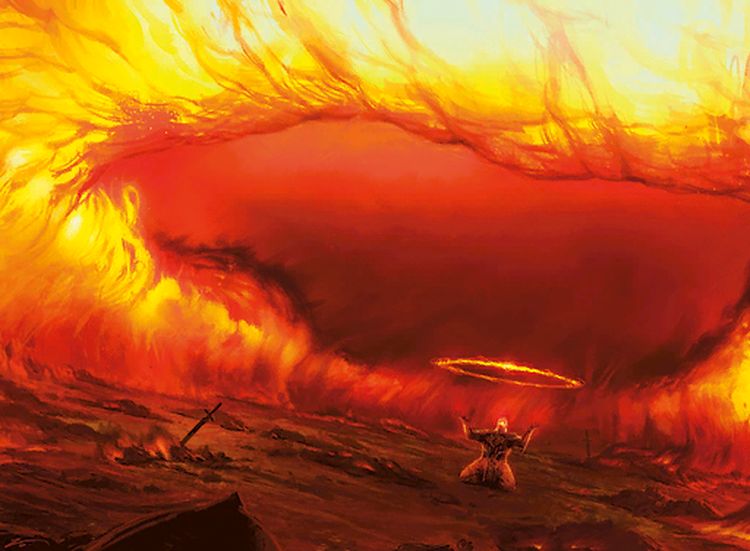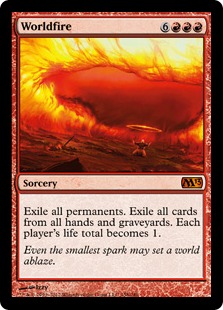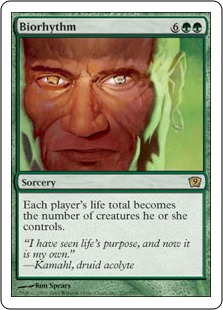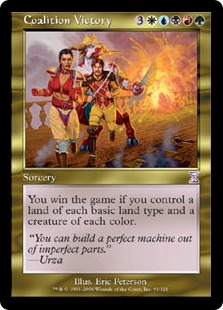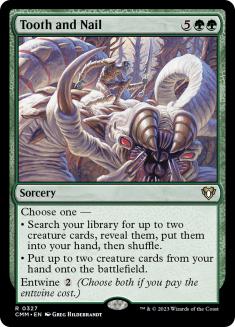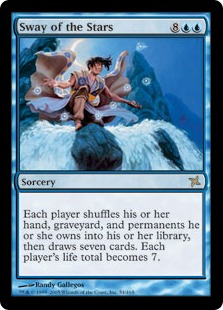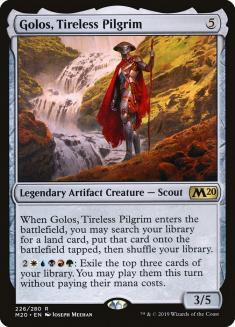We on the Commander Rules Committee (RC) made a significant update in our most recent quarterly announcement. You can check out the specifics on the official RC website. I thought I’d discuss them in more detail here than the announcement generally has room for. I’ll drop the relevant portion of the update language at the top of each section.
Rule 10 Is Removed
Rule 10, which stated that commanders were subject to the legend rule, was created in the days when the legend rule was less stable; the rule remained as an artifact of that time. It’s not a Commander-specific rule, but simply existed as a clarification. Since it’s redundant, we chose to eliminate it. This change is administrative only and will have no impact on how games are played. Rule 11 bumps up to Rule 10.
Removing Rule 10 was easy. I was discussing Rule 11 (which gets a great deal of chatter) one day not so long ago and someone asked, “So what’s Rule 10?” As I ticked off the rest of the rules, I had to confess that I couldn’t name it. It was the springboard to examining whether it was necessary or not. I asked the other three RC members why we hadn’t already gotten rid of it; the answer was we simply hadn’t gotten around to it. There’s no weight to the timing, just a simple realization that it’s a minor detail that got lost in some very tall weeds.
As we mention in the announcement, the former Rule 10 is not a Commander-specific rule. While everything in the sentence “Commanders are subject to the Legend rule; a player cannot control more than one legend with the same name” is true, that’s simply a rule of Magic (Rule 704.5j). In our constant effort to make the Commander rules and everything associated with getting into and playing the format as straightforward as possible, this deletion is well-warranted.
Worldfire Is Unbanned
Worldfire was banned due to the problematic interaction with floating mana and having access to your Commander. We want to foster a Commander environment where 8- and 9-mana spells are viable and likely to show up in a game, so we evaluate the expensive ones in that context. Unlike Coalition Victory and Biorhythm, which we continue to believe are problematic in that environment, the level of effort needed to make Worldfire effective is sufficient that we suspect it will not be as much of an issue. There are already cheaper ways to do similar things in the format. We believe the social contract and robust pregame discussions will keep Worldfire out of games in which it doesn’t belong.
Unbanning Worldfire was much more than the discussion of a single card. In the consciousness of many folks, those chats revolve around all the high-mana spells on the banned list, mostly involving Biorhythm and Coalition Victory. Sway of the Stars sometimes jumps in there as well. We generally don’t ban or unban cards comparatively; we judge them on their own merits while understanding that no card exists in a vacuum.
Knowing that the association exists, we certainly looked at them as a contextual group. They were pretty easy to separate, though. While they all do indeed share the fact that they cost eight or more, there are subtle but significant enough differences to not drop them into the same bucket. As always, please remember that this discussion is in the context of the format as its played in the broad scope of its target demographic and largest part of its player base. The arguments may not hold similar value at the super-powered end of play.
Biorhythm is pretty easy to throw off the raft right away. Eight mana can be trivial in green, especially with the help of mana creatures, like Llanowar Elves. Those same creatures that fuel the spell protect the caster’s life total. A Turn 4 or Turn 5 Biorhythm, when other players are just getting their engines running, creates a pretty uninteresting game. Sweepers are pretty common in the format, so the sweeper into Biorhythm line is also pretty unappealing from a gameplay perspective, especially when it can also just create a draw. A green sorcery — regardless of cost — dealing 150+ damage by itself is also a pretty significant break of the color pie. Biorhythm has a high probability of unintentionally wrecking games, something we’d definitely like to avoid.
We’ve long maintained that we’re not fans of “win the game now” cards. Coalition Victory is one of them. Sure, many players might want to consider running more interaction than they currently do, but “you must have interaction right now” isn’t the same argument. “Win the game” cards with a temporal condition, like Felidar Sovereign or Azor’s Elocutors, are fine. They give the table a whole turn cycle to have a chance at doing something about the impending end of the game. Coalition Victory’s condition is easy to fulfill with simply your commander (although I understand that there are five-color commanders that aren’t all five colors, like Sisay, Weatherlight Captain and the one we’ll talk about momentarily) and you can close the land requirement with just three shocklands or two Triomes.
Yes, it costs eight. Even with our desire for eight-plus-mana spells to be viable in the format, the idea that someone needs a counterspell (or targeted creature removal) right now or everyone loses leads to the kinds of games that leave a bad taste.
Compare Coalition Victory to another expensive spell, an entwined Tooth and Nail. When you resolve Tooth and Nail, even with what we normally consider game-winning combos, at least one other action has to happen. You have to attack with the creatures that have been buffed by Craterhoof Behemoth. Triskelion has to target something or someone, and so on. Each of those subsequent actions has a chance to fail / be countered / be interacted with at some point along the way, in more ways than just a counterspell.
While the chances might be slim depending on the gamestate, they still exist. Creature removal for the Mikaeus or Stifle on the undying trigger. A bounce spell. And so forth. Again, the window is narrow, but it exists for more than that moment. Once Coalition Victory resolves without getting rid of one of the creatures or lands, we’re done. Add to all this that you can do what many players do and simply cast Tooth and Nail for value; you don’t actually have to end the game with it. The same options don’t exist with Coalition Victory; resolve and win. The small difference is a big deal.
The thing that Sway of the Stars does that Worldfire doesn’t is refill its caster’s hand. The mana float then becomes something that you have fuel for. Sway costs ten, so you need a pretty big pile of mana to make it worthwhile, but after it resolves you have options that the other players don’t and aren’t going to. Sway of the Stars is the card that might be closest to Worldfire, but the differences are significant enough to give one a chance and leave the other where it is.
If you have enough mana to float for after Worldfire, you’re limited to casting a single thing: your commander. You might be lucky and have this be the first time you cast it, so you’re not also saddled with paying commander tax. An expensive commander will put an even heavier burden on your mana production. I doubt that we see a rash of Norin the Wary/Worldfire decks post-unban. Sure, if you resolve Worldfire and your commander is Zo-Zu the Punisher, then GGs.
While it’s possible to do Worldfire shenanigans with Jhoira of the Ghitu (just like Sway of the Stars), it doesn’t seem as though the strategy is played so much as to be of concern. We don’t think that returning Worldfire to the card pool will change anything regarding that strategic line. The multiple factors working against the possibility that it has a negative impact on the format lead us to believe that it’s a safe unban.
Golos Is Banned
Golos, Tireless Pilgrim has been a much-discussed card that is both popular to play with and unpopular to play against. There are many problems with the card, but the greatest is that in the low-to-middle tiers where we focus the banlist, Golos is simply a better choice of leader for all but the most commander-centric decks. Its presence crushes the kind of diversity in commander choice which we want to promote. You can drop in Golos and a few 5-color lands into a random deck and get all the ramp and card advantage you would ever want from a commander, with no worries about your mana base. Golos’ ability effectively reduces the commander tax to one and once you hit seven mana (with Golos assuring that you have WUBRG and helping you get there quickly), you don’t need to do anything for the rest of the game except cast spells for free — something we always want to be careful about. We’ve talked to the folks in Studio X and they understand the problems created by generically-powerful five-color commanders that don’t have WUBRG in their mana cost. We don’t expect similar cards to come from them in the future, so a surgical strike now makes sense. We understand that many players love Golos, so we don’t take this action lightly. In the end, the health of the format is our primary concern and we find Golos unhealthy. While Kenrith, the Returned King is a similarly flexible and popular commander for good stuff five color decks, we see it as a clear step down from Golos.
The bannng of Golos, Tireless Pilgrim is the biggest thing in this update and has one of our longest explanation paragraphs ever. I’ll expand on what we said in the announcement. First and foremost, we understand that some people are going to be unhappy with the decision. Their argument will likely be that they loved playing Golos (understandable) and it wasn’t hurting anything (this is where we disagree). I’ll ask those players to look beyond their own enjoyment and attempt to see the bigger picture.
The card is problematic on many axes, all of which combine into a strong argument for banning it. In my mind, the most important is that it’s too generically good — which is, of course, what has led to its runaway popularity.
Where the first falling boulder leads to the avalanche is that it has a five-color identity, but it doesn’t cost WUBRG to cast. With a five-color commander, you have no restriction on what you can play in your deck. You get to pick from all the best spells legal in the format. The price you generally pay for that is that your commander is more difficult to cast and your manabase can get kind of awkward.
Golos negates both of those issues by having no color requirements in its casting cost, and then helping you smooth out the manabase by virtue of simply casting it and having it enter the battlefield. You get to search for any land card, not just basic land. If there were a five-mana noncreature artifact that did the same thing, it would definitely see play. This one’s a creature and can come out of the command zone, get easily blinked and bounced, and so on. Like we say in the announcement, it effectively reduces the commander tax to one, making it easier to get repeated castings, accelerating the whole process.
Conversations about the danger of five-color commanders that don’t cost WUBRG started in earnest during my time in Studio X in late 2019. I did my best to impress on my fellow designers the dangers such commanders posed to the format. The RC as a group then kept up that argument during our many discussions with the various Commander design teams.
Looking at the last few sets, Strixhaven and Adventures in the Forgotten Realms (and even the previews from Innistrad: Midnight Hunt), which were under design and development when we began the conversation, I think we can clearly see the move towards commanders that are more niche and have designs that you can tinker with. When Commander Architect Gavin Verhey visited me for a few days back in June, we had the culmination of those talks. I can tell you that they’ve heard our message loud and clear, understanding the land mines presented by generically good commanders like Golos. I suspect they’ll tread carefully for some time to come.
Once you cast Golos, you’re only one land drop away from the activated ability, which is a whole new kettle of fish. Abilities which cast spells for free are very good. They’re also the kinds of things that you have to really keep an eye on. Casting things for free as the result of a triggered ability, like with Diluvian Primordial, is relatively easy to contain. Having it as an activated ability that doesn’t cause Golos to tap next-levels things pretty quickly. If any of those cards you cast let you untap lands, we get into absurdity in very short order.
Even if you’re only using the ability once per turn cycle (most often on your own turn, since Golos doesn’t change when you can cast the spells), playing three things for seven mana is ridiculous value. You’d normally pay six to nine mana in activated abilities just to draw those three cards. Chances are that one of them is a land, but just casting two of them is money in the bank. Because you don’t play them as part of the resolution of the ability, you have a great deal more flexibility in how you sequence them.
That’s just what the card does on the battlefield. It also has impact on the format itself. Its simple presence means that some other commanders don’t have a chance and that’s not a good circumstance. Golos is an easy default, so some of the exploration of unusual themes and deck styles gets lost. We really want Commander to be about the unusual, things like Dune-themed decks, Ladies Looking Left, and whatever wild things brewers come up with. Golos actively pushes quirky commanders and outside-the-box themes aside, leading to homogenization.
When a commander leads players into just jamming the same cards into decks, we find it intensely problematic. We don’t ban cards lightly. To be honest, we don’t like banning cards at all—but when one has such a sweeping impact on the format, we are compelled to take action.
We’d love to hear your well-reasoned thoughts on any element of the announcement. Head on over to the Commander RC Discord and pop into the #quarterly-announcement channel for what promises to be lively discussion and debate.
Visit my Decklist Database to see my Signature Decks, the Chromatic Project, and more!

